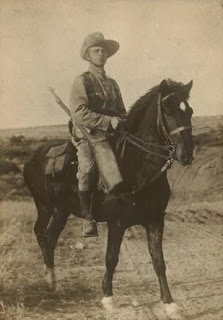 |
| Leuntant Weiss, flanked by Simon Kooper and Henrick Witbooi |
 |
| Bezirksamtmann v. Burgsdorff with Hendrick Witbooi and Simon Kooper |
Longtime allies of Hendrick Witbooi, Simon Kooper's Nama fought against the Germans with the Witbooi in the 1890s, and joined with the Witboois once again in the war against the Germans in 1904-1908. In the photographs, Kooper wears the imperial armband of Germany's native auxiliaries, but was quick to side with the Witboois when they rose up in October, 1904.
Despite his advanced age, Simon Kooper proved a tenacious are resilient guerrilla leader. Among his reported extraordinary accomplishments, he is said not only to have survived imprisonment on the notorious Shark Island, where there was a 90% death rate, but to have actually escaped from it and returned to the field. Although this claim requires further substantiation, there is no doubt that he fought the Germans in numerous battles alongside both the Witboois and the forces of Jakob Morenga, and that he lead the very last Nama resistance group in the field well into 1908. The Germans actually attached him in the Bechuanaland Protectorate where he had taken refuge, and he was ultimately given a pension by the British in 1909. He died in 1913 and is buried near Kaartle pan in Botswana. His grave is inscribed both in German and in Damara/Nama.









